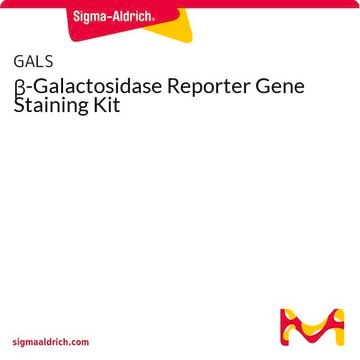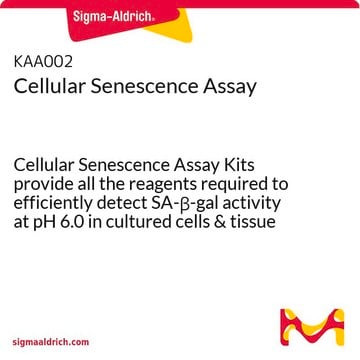GALA
β-Galactosidase Reporter Gene Activity Detection Kit
Sign Into View Organizational & Contract Pricing
All Photos(1)
About This Item
UNSPSC Code:
12352200
NACRES:
NA.32
Recommended Products
sterility
0.2 μm filtered
Quality Level
usage
kit sufficient for 65 tests
shipped in
dry ice
storage temp.
−20°C
Other Notes
The substrate used in this kit is o-nitrophenyl β-D-galactopyranoside (ONPG). ONPG generates a yellow color upon hydrolysis.
related product
Product No.
Description
Pricing
Signal Word
Warning
Hazard Statements
Precautionary Statements
Hazard Classifications
Skin Sens. 1
Storage Class Code
10 - Combustible liquids
Flash Point(F)
Not applicable
Flash Point(C)
Not applicable
Certificates of Analysis (COA)
Search for Certificates of Analysis (COA) by entering the products Lot/Batch Number. Lot and Batch Numbers can be found on a product’s label following the words ‘Lot’ or ‘Batch’.
Already Own This Product?
Find documentation for the products that you have recently purchased in the Document Library.
Customers Also Viewed
Chao-You Pang et al.
Molecular & cellular proteomics : MCP, 9(9), 2019-2033 (2010-06-08)
The quality of cotton fiber is determined by its final length and strength, which is a function of primary and secondary cell wall deposition. Using a comparative proteomics approach, we identified 104 proteins from cotton ovules 10 days postanthesis with
Christian Keggi et al.
Journal of industrial microbiology & biotechnology, 46(1), 1-11 (2018-11-01)
A draft genome of Paenibacillus amylolyticus 27C64 was assembled and a total of 314 putative CAZymes in 108 different families were identified. Comparison to well-studied polysaccharide-degrading organisms revealed that P. amylolyticus 27C64 has as many or more putative CAZymes than
Claudia Massa et al.
The Biochemical journal, 407(2), 207-217 (2007-07-14)
We have recently isolated and heterologously expressed BcPeh28A, an endopolygalacturonase from the phytopathogenic Gram-negative bacterium Burkholderia cepacia. Endopolygalacturonases belong to glycoside hydrolase family 28 and are responsible for the hydrolysis of the non-esterified regions of pectins. The mode of action
V Hugouvieux et al.
Applied and environmental microbiology, 63(6), 2287-2292 (1997-06-01)
The production of endopolygalacturonase (endoPG) by Colletotrichum lindemuthianum, a fungal pathogen causing anthracnose on bean seedlings, was enhanced when the fungus was grown in liquid medium with L-arabinose or L-rhamnose as the sole carbon source. These two neutral sugars are
Ajaya K Biswal et al.
Biotechnology for biofuels, 10, 182-182 (2017-07-21)
The effective use of plant biomass for biofuel and bioproduct production requires a comprehensive glycosyl residue composition analysis to understand the different cell wall polysaccharides present in the different biomass sources. Here we compared four methods side-by-side for their ability
Our team of scientists has experience in all areas of research including Life Science, Material Science, Chemical Synthesis, Chromatography, Analytical and many others.
Contact Technical Service










